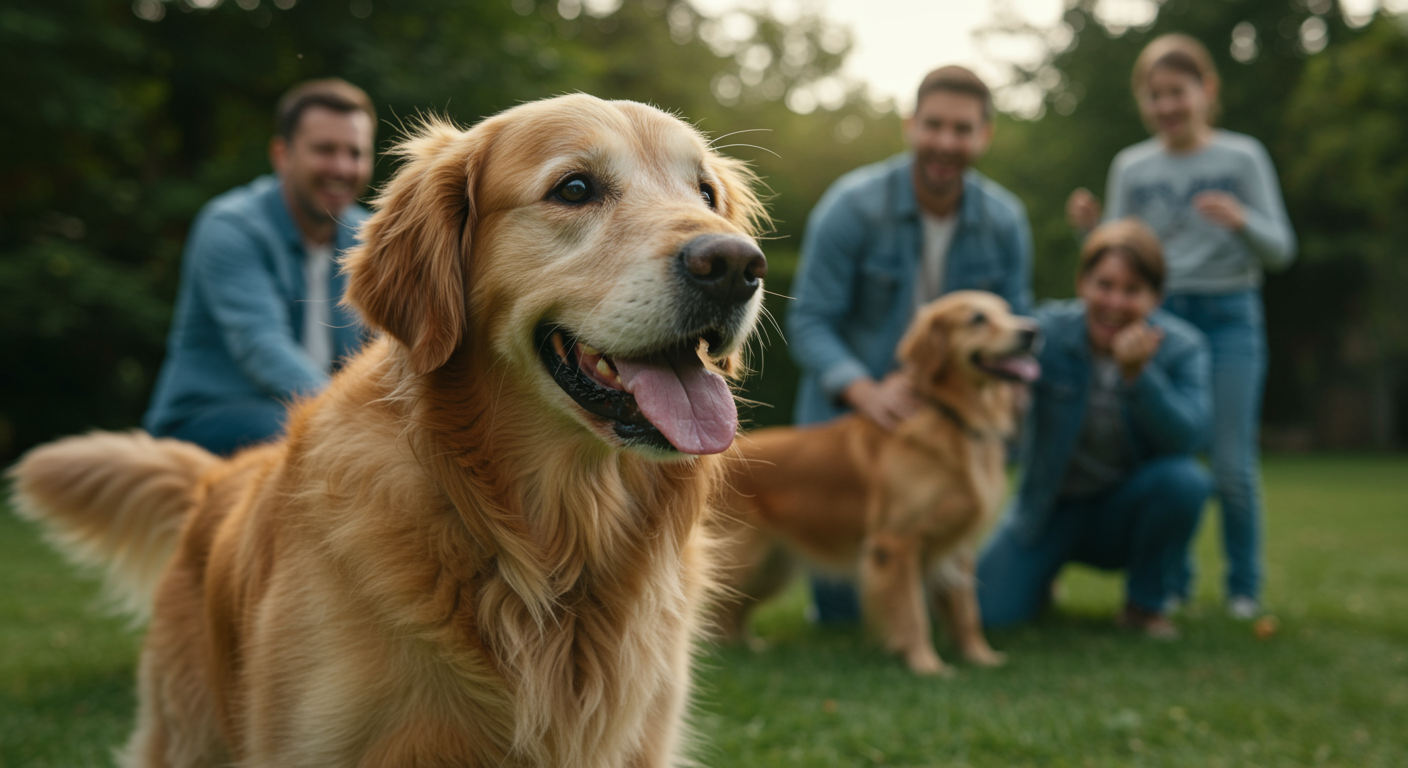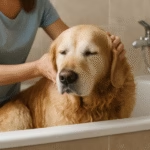The Day My Toddler Became a Chew Toy (Almost)
I vividly remember the scene. Our Golden Retriever puppy, Gus, was about three months old—a fluffy, adorable bundle of pure, unadulterated chaos. My two-year-old daughter, Lily, was toddling happily across the living room carpet. Suddenly, Gus launched himself, all four paws and sharp little teeth, straight at her. He wasn’t aggressive; he was just playing. But in his puppy world, a moving, squealing toddler looked like the most exciting, squeaky toy imaginable. Lily shrieked, stumbled, and burst into tears. My heart seized.
In that moment, I realized that Gus’s boundless enthusiasm, while endearing to adults, could be genuinely frightening and even dangerous for a small child. This wasn’t a problem that would magically fix itself. It required a proactive, consistent, and empathetic strategy. You want your child to love their dog, not fear them. And you want your puppy to learn appropriate boundaries, not be constantly reprimanded for simply being a puppy.
This article isn’t about blaming the puppy or scolding the child. It’s about empowering you, the parent, with a practical playbook to navigate this intense, but temporary, phase. It’s about teaching your Golden how to interact gently with your tiny humans, and teaching your tiny humans how to communicate respectfully with their enthusiastic furry friend. Let’s reclaim the peace (and prevent those tiny teeth from making contact!).
Understanding the “Why”: Inside a Golden Puppy’s Mind
Before we can manage the behavior, we need to understand it. Why do Golden puppies nip and jump so much, especially around kids?
- Exploration: Puppies use their mouths to explore the world. Just like human babies put everything in their mouths, puppies chew to understand textures, shapes, and reactions.
- Teething: From about 3-6 months, puppies’ gums are sore as their adult teeth emerge. Chewing provides relief. Small hands and feet are often the perfect size and texture for this.
- Play Behavior: In a litter, puppies nip and jump at each other as part of their play. If one nips too hard, the other puppy yelps, teaching bite inhibition. When they come to our homes, they try the same behavior on us.
- Attention Seeking: Any reaction—even a negative one like a shout or a push—can be interpreted by a puppy as attention. Jumping and nipping can quickly become learned behaviors if they consistently get a reaction.
- Over-Arousal: Children’s high-pitched voices, quick movements, and running around can quickly overstimulate a puppy, leading to frantic, uncontrolled jumping and nipping.
Our goal isn’t to punish these natural instincts but to redirect them towards appropriate outlets and teach them more acceptable ways to interact.
Part 1: Managing Nipping – The “Gentle Mouth” Protocol
The puppy nipping phase is notorious. Those little teeth feel like needles! Here’s how we successfully taught Gus the concept of a “gentle mouth” around our children.
H3: Rule #1: Teach Bite Inhibition (The “Yelp & Replace” Method)
This is the most crucial step and directly mimics how puppies learn from their littermates.
- The Dramatic Yelp: If Gus’s teeth (even in play) made contact with anyone’s skin (mine, my husband’s, or my older child’s, never the toddler’s initially), we would let out a loud, high-pitched “YIP!” like an injured puppy. This startled him and communicated, “Too hard!”
- Immediate Disengagement: The instant he paused, we would immediately withdraw all attention. No eye contact, no talking. We’d simply stand up and turn our back for 10-15 seconds. If he continued to nip, we’d calmly walk out of the room for a very brief “time out” (30 seconds). This taught him that hard bites made the fun stop.
- The “Kid-Friendly” Modification: For my toddler, Lily, direct intervention was too risky. She couldn’t yelp reliably or disengage safely. So, my rule was: if Gus even looked like he was going to nip Lily, I would immediately redirect him. I always had a high-value chew toy or stuffed Kong handy. The second he eyed her hands or feet, I’d intercept with the chew toy, saying “Chew THIS!” in an excited voice. This saved many tears and prevented him from ever practicing nipping on her.
H3: Rule #2: Always Provide Appropriate Chew Outlets
A puppy needs to chew. It’s a physiological and behavioral necessity. If you don’t provide suitable options, they will find their own (like your child’s favorite toy, or your furniture).
- Variety is Key: Offer a rotation of different textures: rubber Kongs (stuffed with frozen peanut butter or wet kibble), safe nylon chew bones, bully sticks, and braided ropes.
- Accessibility: Have these chew toys readily available in every room your puppy is allowed in.
- Prioritize Over Kids’ Toys: If a puppy is eyeing a child’s toy, immediately intervene with a more appealing dog toy. Make the dog toy the “win.”
H3: Rule #3: Teach Your Kids How to React (and Not React)
Your children’s reactions are powerful. We want to teach them to react in ways that reinforce desired behaviors, not unwanted ones.
- Be a “Tree”: I taught my kids the “Be a Tree” method. If Gus got too mouthy or jumpy, they were to stop moving, cross their arms, and look at their feet. Movement fuels a puppy’s excitement. By becoming still and boring, they teach the puppy that such behavior doesn’t get a reaction.
- “Gentle Hands”: We practiced petting Gus gently on his back and chest, not his face or head, and never grabbing. I’d narrate, “See how happy Max is when you use gentle hands? That’s what he likes!”
- No Roughhousing with Hands/Feet: We strictly avoided using our hands or feet as playthings. This only confuses a puppy into thinking it’s okay to nip. All play was done with toys, not body parts.
Part 2: Managing Jumping – The “Four Paws on the Floor” Mantra
A happy Golden greeting can easily bowl over a child. Teaching them to keep all four paws on the floor is essential for safety.
H3: Rule #1: The Power of Ignoring
This is the most effective tool, but it requires ironclad consistency from everyone.
- No Attention for Jumping: As soon as Gus jumped up, everyone in the family (kids included, after explicit training) learned to immediately turn their back, cross their arms, and completely ignore him. No eye contact, no pushing him down, no talking. Jumping gets zero attention.
- Reward the Calm: The instant all four paws were back on the ground, we would turn around, offer calm praise (“Good four paws!”), and a gentle pet or a small treat. We were essentially teaching him: “Jumping makes me disappear. Four paws on the floor makes me appear and give you attention.”
H3: Rule #2: Consistent Training for “Sit” to Greet
Once Gus had a solid “Sit” command, we used it every time he wanted to greet someone.
- Practice with Purpose: I’d have a family member (or even a calm friend) approach the door. If Gus jumped, they’d turn and ignore. The second he sat, they’d calmly open the door, step in, and give him a gentle pet and a treat while he was still sitting.
- Kid’s Role in “Sit to Greet”: My older child learned to ask Gus for a “Sit” before petting him. If Gus jumped, they’d “Be a Tree.” The instant he sat, they’d give the “Go ahead” to pet. This empowered the kids and reinforced the desired behavior.
H3: Rule #3: Managing Over-Arousal (Especially Around Kids)
Often, jumping and nipping come from over-excitement, especially with the high energy of children.
- Pre-emptive Exercise: A tired puppy is a good puppy. Before a highly anticipated play session with the kids, I’d take Gus for a vigorous game of fetch or a short walk to burn off some of his excess energy. This made him calmer and more receptive to learning.
- Calm Greetings: We actively trained our kids to greet Gus calmly, especially when they came home from school. Instead of running in screaming, they learned to walk in, crouch down, and offer a soft, inviting voice. This prevented him from getting too worked up.
- Scheduled Downtime: Puppies need a lot of sleep. If Gus was getting overly excitable and unruly around the kids, it was often a sign he was overtired. I’d calmly lead him to his crate for a mandatory nap time. This saved everyone’s sanity.
Conclusion: Patience, Consistency, and a Whole Lot of Love
The puppy phase of nipping and jumping can feel like an endless battle, especially when you’re also juggling the demands of young children. There will be days of frustration, tiny nips that draw a tear, and moments when you wonder if you made the right decision.
But please, remember this: this phase is temporary. With consistent, positive reinforcement, a strong focus on redirection, and a whole lot of patience, your Golden Retriever puppy will learn how to be a gentle, polite, and safe companion for your children. Every “yelp,” every ignored jump, every successful “sit” for a treat, is a brick in the foundation of a beautiful, lifelong friendship. You are not just training a dog; you are cultivating a relationship built on understanding and respect. And that, my friend, is worth every bit of effort.
A Real-Life Tip: My secret weapon for managing the “witching hour” (that time in the late afternoon when both kids and puppy are overtired and overstimulated) was a frozen, stuffed Kong. I’d stuff a Kong with a mix of peanut butter, wet food, and kibble, and freeze it. When the chaos started to escalate, I’d pull out the frozen Kong and give it to Gus in his crate. It occupied him mentally and physically for 30-45 minutes, gave him a positive chewing outlet, and gave everyone else a much-needed break from the puppy exuberance. It was a lifesaver.

Rafael Souza is a digital marketing strategist and lifelong dog enthusiast. Passionate about Golden Retrievers, he shares practical, research-based tips to help owners provide healthier and happier lives for their furry companions.





